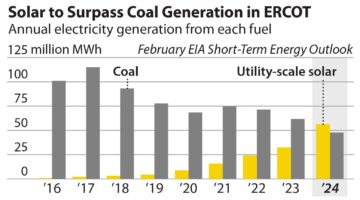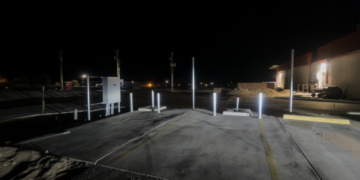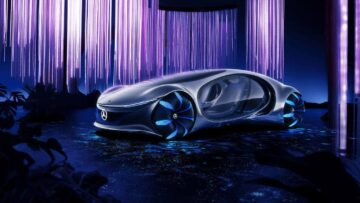Sign up for daily news updates from CleanTechnica on email. Or follow us on Google News!
If you’re looking for a nice, dark place to see the stars at night in all of their glory, you’d be hard-pressed to find a better place than Big Bend National Park. Being far from not only cities, but even a ways from all but the smallest towns, there’s just not that much light pollution to ruin the view. So, the park has about the darkest skies you can find in the United States.
But one downside to being far from the lights of the city is that you’re also far from big electrical connections. This meant for a long time that the only way to get a charge would be to plug into a 50-amp circuit at an RV park, either in the nearby small town of Terlingua or in one of the park’s campgrounds (which apparently no longer even has hookups). Eventually, some of the businesses in the area got destination chargers, but that’s not much faster than the RV park solution, leaving you to need to charge overnight.
Even getting that far could prove to be a bit of a challenge until early this year. The closest DC fast chargers were all along Interstate 10, with the closest one being almost a three-hour drive away from the park.
This started to change when Tesla’s Supercharger station in Alpine, Texas, went online on January 18th. This meant that the route in through Terlingua was now only about 100 miles from the nearest DC fast charger. Even better, it’s a new V3 station that will soon be open to nearly all EVs with an adapter, so the park is going to be even more accessible to everyone traveling under electric power.
But that 100-mile route is still tough for many EVs, because you still have to go back, making it a 200-mile round trip before you start driving around the many miles of road in the park. So, there’s still a need for Level 2 charging and likely an overnight stay outside of the park to get charged up enough to comfortably enjoy the park to its fullest.
And, for people pulling a trailer, that’s an even harder proposition. So, electric RVing is still quite a challenge.
But that too is about to change. According to both PlugShare and Supercharge.info, the park is about to become far, far easier for everyone to get to. A new station with 8 V3 stalls, with NACS compatibility, is going in in Terlingua. The station will be located at Basecamp Terlingua, a local glamping site that has had Level 2 charging for years.
This will make it a drive of only about 50–60 miles to go from the nearest charger all the way across the park, putting the whole park well within a round-trip reach of the charging network, even for most EVs with less range. You’d probably still want to do some planning for long drives across and around the park, but for people staying multiple nights in the area, being able to pop out and get a charge and go back in is still very helpful. Either way, trip planning with waypoints within the park is still a good idea.
Expanded Opportunities This Provides (Beyond Simply Getting There)
Another thing this station will greatly help with is people who want to pull a travel trailer and use the vehicle to power luxuries like air conditioning. By leaving Terlingua with a near-full charge, someone doing that could have plenty of power to spend days inside the park, power some life support at night as needed, and still make it back out to the Supercharger. This alone will mean a lot for people traveling that way.
Another great thing this station is going to add for people is the ability to easily visit Big Bend Ranch State Park. Situated on the other side of Terlingua, it has many beautiful sights like the national park, along with some things you can’t find anywhere else. It also has more opportunities for mountain biking, off-roading, and other things the national park isn’t as happy to accommodate.
Between the two parks, there are plenty of “primitive camping” opportunities for both RVs and tents. Being able to carry some power out to the campsite from Terlingua will make these cheap and more natural camping experiences available to many more people, and more comfortable for everybody.
My Bolt EUV can’t quite make it (I checked on ABRP), but for vehicles with longer range, trips into Mexico are now a little easier. A Tesla Model 3 Long Range will now be able to get from the Big Bend area to Chihuaha’s fast chargers with 11% to spare, for example. At present, this still leaves most EVs out of reach of the next chargers going south in Torreón without some L2 charging or hypermiling, but as Mexico’s EV charging network grows, this will be a nice route for some vacationers to take, and maybe even open up some commercial travel routes as EVs become more popular.
More Work To Do, & Money To Be Made
I’m very happy about what Tesla is doing here, and I wanted to give credit where credit is due. But, as awesome as this really is, there’s still a lot of room for more charging infrastructure in the region. That said, this problem is just an opportunity in work clothes and there’s some money to be made by forward-looking businesses, especially those whose names don’t start with a T.
For one, the US-90 corridor really needs more charging. Marfa and Fort Davis are obvious candidates for additional stations, but the tiny community of Valentine could use a stop-gap charger, and other places like Marathon, Sanderson, Dryden, and Langtry all need at least something. The national park itself probably needs some charging, too. The easiest way to serve most of these places will be with a couple of battery-storage powered stalls, like those sold and now sometimes even provided by FreeWire Technologies.
On the north side of I-10/20, there are two other national parks that don’t have great charging access from anybody, including Tesla. Guadalupe Mountains and Carlsbad National Parks both are pretty far from the nearest DCFC stations, with steep terrain making it a challenge for cars trying to live at the edge of their range.
This is something that can be done, and will be done. It’s just a question of who’s going to make a buck doing it!
Featured image by L. Bartsch, National Park Service (Public Domain).
Have a tip for CleanTechnica? Want to advertise? Want to suggest a guest for our CleanTech Talk podcast? Contact us here.
Latest CleanTechnica TV Video
[embedded content]
Advertisement
CleanTechnica uses affiliate links. See our policy here.
- SEO Powered Content & PR Distribution. Get Amplified Today.
- PlatoData.Network Vertical Generative Ai. Empower Yourself. Access Here.
- PlatoAiStream. Web3 Intelligence. Knowledge Amplified. Access Here.
- PlatoESG. Carbon, CleanTech, Energy, Environment, Solar, Waste Management. Access Here.
- PlatoHealth. Biotech and Clinical Trials Intelligence. Access Here.
- Source: https://cleantechnica.com/2024/03/29/big-bend-national-park-will-be-easy-for-evs-soon/
- :has
- :is
- :not
- :where
- $UP
- 10
- 100
- 18th
- 2%
- 400
- 8
- a
- ability
- Able
- About
- access
- accessible
- accommodate
- According
- across
- add
- Additional
- Advertise
- Affiliate
- AIR
- Air Conditioning
- All
- almost
- alone
- along
- also
- an
- and
- anywhere
- ARE
- AREA
- around
- AS
- At
- available
- away
- awesome
- back
- BE
- beautiful
- because
- become
- before
- being
- Better
- Beyond
- Big
- Bit
- Bolt
- both
- businesses
- but
- by
- camping
- CAN
- candidates
- carry
- cars
- challenge
- change
- charge
- charged
- charging
- cheap
- checked
- circuit
- Cities
- City
- cleantech
- Cleantech Talk
- closest
- clothes
- comfortable
- commercial
- community
- compatibility
- Connections
- content
- corridor
- could
- Couple
- credit
- Dark
- Davis
- Days
- dc
- destination
- do
- doing
- domain
- done
- Dont
- downside
- drive
- drives
- driving
- due
- Early
- easier
- easiest
- easily
- easy
- Edge
- either
- Electric
- else
- embedded
- enjoy
- enough
- especially
- Ether (ETH)
- EV
- Even
- eventually
- everybody
- everyone
- evs
- example
- Experiences
- far
- FAST
- faster
- Find
- For
- Fort
- forward-looking
- from
- get
- getting
- Give
- glory
- Go
- going
- good
- got
- great
- greatly
- Grows
- Guest
- had
- happy
- harder
- Have
- help
- helpful
- here
- HTTPS
- i
- idea
- image
- in
- Including
- Infrastructure
- inside
- into
- IT
- ITS
- itself
- January
- just
- l2
- least
- leaves
- leaving
- less
- Level
- Life
- light
- lights
- like
- likely
- links
- little
- live
- local
- located
- Long
- long time
- longer
- looking
- Lot
- made
- make
- Making
- many
- Marathon
- max-width
- maybe
- mean
- meant
- Mexico
- model
- money
- more
- most
- Mountain
- much
- multiple
- names
- National
- National Park
- national parks
- Natural
- nearly
- Need
- needed
- needs
- network
- New
- news
- next
- nice
- night
- no
- North
- now
- obvious
- of
- on
- ONE
- online
- only
- open
- opportunities
- Opportunity
- or
- Other
- our
- out
- outside
- overnight
- Park
- parks
- People
- Place
- Places
- planning
- plato
- Plato Data Intelligence
- PlatoData
- player
- Plenty
- plug
- podcast
- policy
- Pollution
- pop
- Popular
- power
- powered
- present
- pretty
- probably
- Problem
- proposition
- Prove
- provides
- public
- pulling
- Putting
- question
- quite
- range
- reach
- really
- region
- road
- Room
- round
- Route
- routes
- ruin
- Said
- see
- serve
- service
- side
- Sights
- simply
- site
- situated
- skies
- small
- smallest
- So
- sold
- solution
- some
- Someone
- something
- Soon
- South
- spend
- Stars
- start
- started
- State
- States
- station
- Stations
- stay
- staying
- steep
- Still
- suggest
- support
- T
- Take
- Talk
- Technologies
- terrain
- Tesla
- texas
- than
- that
- The
- The Area
- their
- There.
- These
- thing
- things
- this
- this year
- those
- Through
- time
- tiny
- tip
- to
- too
- tough
- town
- towns
- trailer
- travel
- Traveling
- trip
- trying
- tv
- two
- under
- United
- United States
- until
- Updates
- us
- use
- uses
- vehicle
- Vehicles
- very
- Video
- View
- Visit
- want
- wanted
- was
- Way..
- ways
- WELL
- went
- were
- What
- when
- which
- WHO
- whole
- whose
- Wikipedia
- will
- with
- within
- without
- Work
- would
- year
- years
- you
- youtube
- zephyrnet









